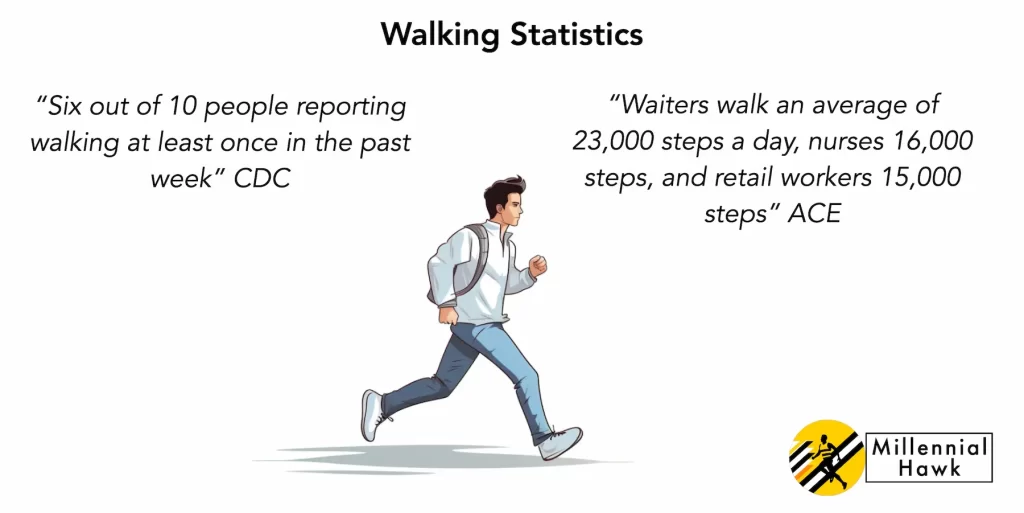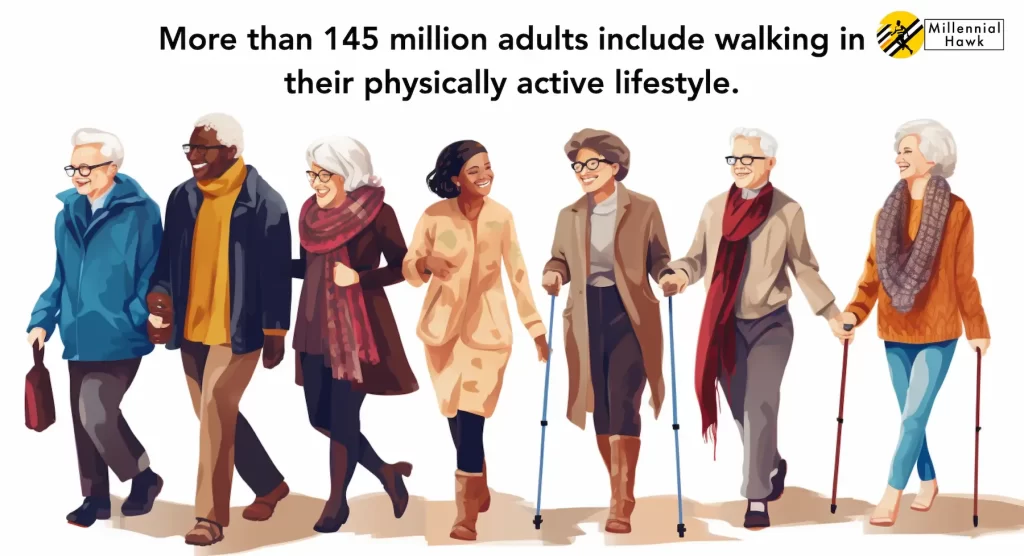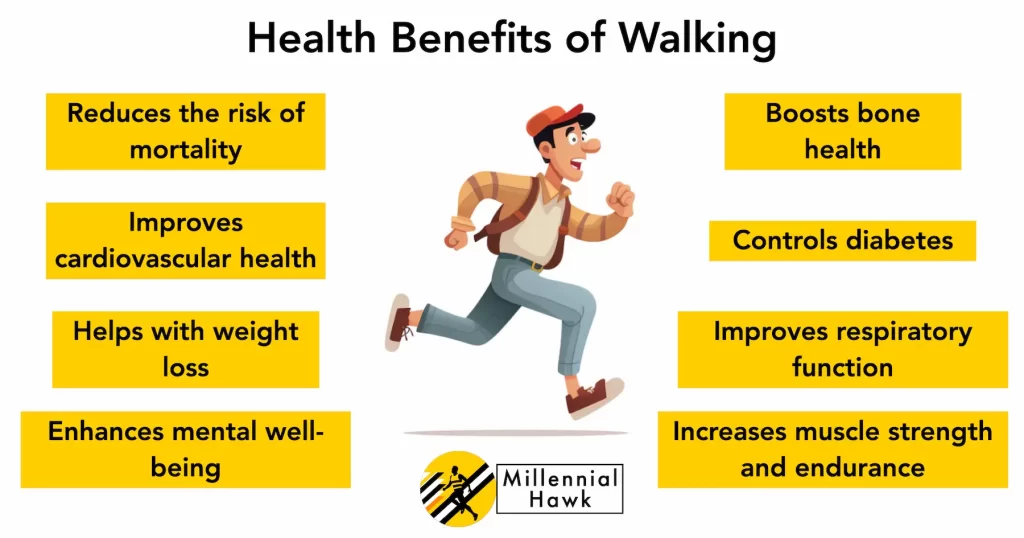Walking is a fundamental and innate human activity that has evolved over millions of years. It serves as a mode of locomotion, exercise, and a sustainable means of transportation.
Walking, as a form of exercise, is a moderate-intensity physical activity characterized by moving at a steady pace, one foot in front of the other. It typically falls within the range of 3-6 METs (Metabolic Equivalent of Task).
Walking can be varied in both duration and intensity to meet specific health and fitness goals. The Centers for Disease Control (CDC) and the American College of Sports Medicine (ACSM) recommend at least 30 minutes of moderate-intensity brisk walking (typically at 3 to 4 mph for most adults) per day. These 30 minutes can be broken down into multiple sessions, provided each session lasts at least 10 minutes.
Walking offers myriad benefits, including improved cardiovascular health, weight management, enhanced mental well-being, increased bone strength, better joint health and mobility, reduced risk of chronic diseases, and longer life expectancy, and is both accessible and affordable for individuals of all ages and fitness levels. This graph illustrates fun facts about walking, according to the CDC and the American Council on Exercise (ACE).

What is Walking?
Walking, also known as ambulation, is the primary mode of terrestrial movement in legged animals, defined by its inverted pendulum gait and the sequential lifting of one foot at a time, differentiating it from running. According to a 1997 study by Jerry Morris, walking is an aerobic activity that, when done briskly at speeds around 6.4 km/h, engages large skeletal muscles, enhances cardiovascular capacity, and expends energy, making it beneficial for weight control, muscle strength, bone health, and overall fitness, especially when maintaining over 70% of maximal heart rate.
Walking is a predominant form of aerobic exercise in the U.S., with about 6 in 10 adults reporting they walked for at least 10 minutes in the past week. According to The Centers for Disease Control, the number of adults who walk for purposes such as transportation, leisure, or exercise has seen a 6% increase over 5 years, rising from 56% in 2005 to 62% in 2010, as shown in this graph.

Despite this positive trend, less than half of all adults achieve the recommended amount of physical activity, which stands at a minimum of 2 and 1/2 hours of moderate aerobic activity like brisk walking per week. While the West and Northeast regions have the highest walking percentages, the South has witnessed the most significant increase in walking activity among its residents.
Walking mechanics tend to decline with age, but the extent to which these changes are natural or due to decreased physical activity remains uncertain.
A 2012 study by Katherine A. Boyer from Stanford University compared younger adults (<40) with older, yet highly active individuals (>50) and found that while older subjects didn’t reduce their walking speed, they altered their walking mechanics: they increased cadence and decreased stride length. Additionally, older adults showed less ankle dorsiflexion at heel strike and reduced plantar flexion at toe-off.
What is the average walking speed?
The average walking speed of healthy individuals varies based on age and gender. According to a meta-analysis by Richard W. Bohannon and A Williams Andrews from the University of North Carolina, the gait speed ranged from a mean of 143.4 cm/second (or approximately 1.43 m/s) for men aged 40 to 49 years to a mean of 94.3 cm/second (or approximately 0.94 m/s) for women aged 80 to 99 years. This video from Eraldo Maglara, an American certified personal trainer, explains the normal walking speed.
What are the health benefits of walking?
Walking offers numerous health benefits, including strengthening the heart, improving circulation, and reducing the risk of cardiovascular diseases. Plus, it aids in weight management, enhances mental well-being, and boosts bone health, making it a comprehensive low-impact exercise for overall health and well-being, as illustrated in this diagram.

- Reduces the risk of mortality: A 2015 study by Wenjing Zhao from Hokkaido University Graduate School of Medicine found that walking ≥2 hours/day was significantly associated with lower all-cause mortality among younger-elderly men, regardless of the presence of major critical diseases.
- Improves cardiovascular health: A study conducted in 2009 by Janne Boone-Heinonen from the University of North Carolina at Chapel Hill revealed that consistent walking can fortify the heart, decrease blood pressure, and enhance circulation, thereby diminishing the likelihood of cardiovascular ailments like heart disease and stroke.
- Helps with weight loss: Engaging in regular brisk walking has been shown to effectively improve multiple cardiovascular risk factors. A 2007 study led by Marie H Murphy from the University of Ulster at Jordanstown revealed that such walking interventions notably reduced body weight and BMI, emphasizing its significance in weight management and overall health enhancement.
- Enhances mental well-being: In a 2018 study by Paul Kelly from the University of Edinburgh, walking has demonstrated positive effects on mental health, with substantial evidence highlighting its benefits, particularly for depression. However, while the body of evidence supporting walking’s mental health advantages is expanding, it remains fragmented for some outcomes, emphasizing the need for further research to address these gaps and for policy guidelines to advocate for the established mental health benefits of walking.
- Boosts bone health: In a 1994 research article from The American Journal of Medicine titled “Walking is related to bone density and rates of bone loss,” it was highlighted that walking significantly impacts bone health, particularly in postmenopausal women. The findings showed that women who cover more than 7.5 miles per week through walking have a higher overall bone density than those walking less than 1 mile per week, and regular walking can effectively slow down bone loss in the legs.
- Controls diabetes: Regular walking training, particularly when supervised, has been shown to enhance glucose control in individuals with type 2 diabetes mellitus (T2DM), yielding positive effects on cardiorespiratory fitness, body weight, and blood pressure. A 2020 study by Paolo Moghetti from the University of Verona indicates that even brief walking sessions, aimed at interrupting prolonged sitting, can improve glucose profiles in sedentary diabetic patients.
- Improves respiratory function: In a 2014 study by Thomas Wibmer from the University Hospital of Ulm, it was found that for individuals with stable COPD, lung volumes measured right after a 6-minute walk test (6MWT) offer a clearer indication of exercise constraints compared to baseline lung volumes taken before the 6MWT, except for FEV1. The study suggests that to effectively gauge exercise-induced breathing limitations in COPD research, pulmonary function assessments should be performed post-exercise, as the traditional resting baseline tests may not capture the full picture.
- Increases muscle strength and endurance: After a year-long brisk walking program, the participants, on average, engaged in 157 minutes of brisk walking per week, leading to a significant increase in their brisk walking speed from 1.73 m/s to 1.88 m/s. Despite maintaining their energy intake, a 1992 study by Adrianne Hardman from Loughborough University found that brisk walking enhanced endurance fitness, evidenced by improved oxygen uptake and decreased heart rate, without altering body fat distribution.
Apart from the aforementioned benefits, walking also fosters joint health, bolsters the immune system, prolongs life expectancy, aids in better sleep quality, diminishes stress and anxiety, elevates energy levels, and serves as a sociable and pleasurable activity.
What are the health benefits of walking for older adults?
The health benefits of exercise, such as walking for older adults include improved balance and coordination, which can help prevent falls and reduce the risk of injuries.
According to a 2011 study by Alexander Voukelatos titled “The effect of walking on falls in older people,” walking also promotes cardiovascular health, reducing the risk of heart disease, stroke, and high blood pressure.
Regular walking, regardless of its type, can strengthen muscles and bones, improving overall physical strength and mobility. Additionally, walking can have positive effects on mental health, reducing symptoms of depression and anxiety, and improving cognitive function. This video from ABC News shows the benefits of walking for older adults.
What are the different types of walking?
The different types of walking are listed below.
- Leisure walking: Leisure walking refers to engaging in walking activities for enjoyment and leisure purposes, rather than as a means of transportation or for exercise. It involves taking leisurely walks in parks, nature trails, or other scenic areas at a comfortable pace. Leisure walking allows individuals to relax, enjoy the surroundings, and improve their mental well-being.
- Bushwalking: This term is commonly used in Australia and refers to a form of walking or hiking through forested areas or natural environments. Bushwalking allows individuals to immerse themselves in nature, which has been shown to have positive effects on mental well-being.
- Racewalking: Racewalking is a competitive sport that involves walking at a fast pace while maintaining specific rules and techniques. This technique, known as “bent knee, straight leg,” allows racewalkers to achieve higher speeds while still maintaining an upright posture. It is an Olympic event and requires walkers to keep one foot in contact with the ground at all times.
- Power walking: Power walking is a form of exercise that involves walking at a faster pace than normal and with greater intensity. It is a purposeful and brisk walking style that requires a more vigorous effort compared to leisurely walking. Power walking typically involves swinging the arms and taking longer strides to increase the intensity of the exercise.
- Beach walking: Walking on sandy beaches can provide a unique experience and challenge the muscles in different ways. It is a popular activity in coastal areas and can be combined with other beach activities.
- Hillwalking: Hillwalking involves walking in hilly or mountainous terrains. It often requires more endurance and can be a challenging activity that offers scenic views.
- Nordic walking: Nordic walking is a form of physical activity that involves walking with the use of specially designed poles. It originated in Finland in the 1930s as a training method for cross-country skiers during the summer months. Nordic walking has gained popularity as a low-impact exercise option for people of all ages, especially the elderly.
- Trekking: Trekking is a form of exercise that involves walking in nature, often on uneven terrain or through mountainous regions. It is a popular recreational activity and also a recognized form of physical fitness training. In the context of the mentioned study, trekking refers to downhill walking as part of a structured exercise program for older obese women.
- Dog walking: Walking with dogs is a popular activity among pet owners. It provides exercise for both the dog and the owner and can be done in various environments, such as parks or designated dog walking areas.
- Hiking: Hiking is commonly used to describe long, vigorous walks. It is a term widely used in Canada, the United States, South Africa, New Zealand, Australia, the UK, and Ireland. Hiking can range from short day hikes to multi-day backpacking trips.
These are just a few examples of the different types of walking that people participate in.
Which type of walking should be included in the workout plan?
You should include power walking in your walking workout plan if you are looking for more intense exercise. Power walking consumes up to 55% more energy compared to regular walking without arm movement. It has greater energy consumption benefits than running at speeds equal to or greater than 8 km/hr, yet it’s at a lower intensity.
However, for those starting out or with sedentary lifestyles, regular walking at a speed of around 4.67-4.81 km/hr can be beneficial for improving cardiovascular endurance and aiding in weight and body fat reduction.
What are the common barriers to walking?
Common barriers to walking include factors such as poor weather conditions, time constraints, difficulty walking due to health or physical limitations, personal health issues, and lack of motivation. Additionally, concerns such as arthritis, fatigue, safety, family or work obligations, lack of enjoyment, and absence of a walking partner further impede individuals from engaging in walking activities.
- Poor Weather Conditions: Weather plays a significant role in determining one’s willingness to walk. Adverse conditions such as extreme heat or cold, rain, snow, or strong winds can deter individuals from walking outdoors. Some might not have the appropriate attire for the specific weather condition, while others might be concerned about slipping in rainy or snowy conditions.
- Time Constraints: With busy schedules, many people find it challenging to allocate time specifically for walking. Work, school, and other commitments can eat into the day, leaving little room for recreational activities or exercises like walking.
- Difficulty Walking: Certain physical limitations or disabilities can make it challenging for individuals to walk. Conditions like sprained ankles, fractures, or more long-term disabilities can act as barriers.
- Personal Health Issues: Some individuals might have health conditions that restrict or limit their ability to walk for extended periods. Cardiovascular issues, respiratory problems, or recent surgeries can be some reasons.
- Lack of Motivation: Without a clear goal or motivation, some might find it hard to take the initiative to walk regularly. Having a structured plan or a clear reason, like weight loss or improving cardiovascular health, can be a driving factor for many.
- Arthritis: Arthritis can cause pain and discomfort in the joints, making walking a painful activity for many. Swollen joints or stiffness can limit the range of motion, reducing the desire to walk.
- Fatigue: Feelings of constant tiredness or exhaustion can act as significant barriers. Physical or mental fatigue can reduce the energy levels required for activities like walking.
- Safety Concerns: In certain areas, concerns about personal safety, especially during late hours, can deter individuals from walking. Lack of well-lit areas, presence of stray animals, or concerns about crime can be deterrents.
- Family or Work Obligations: Responsibilities related to families, like childcare or eldercare, can take precedence over personal exercise time. Work demands, especially for those with long hours or multiple jobs, can leave little time or energy for walking.
- Lack of Enjoyment: Not everyone enjoys the act of walking. Some might find it monotonous or might prefer other forms of exercise or recreation.
- Absence of a Walking Partner: For many, having a companion can make walking more enjoyable and act as a motivation. The absence of a partner or group can reduce the incentive for those who prefer social activities.
Understanding these barriers to exercise can be the first step in finding ways to overcome them and incorporate walking into one’s workout routine.
What are the common physical limitations to walking?
The following are the most common physical limitations to walking.
- Heel Pain When Walking: Heel pain, often caused by conditions like plantar fasciitis, can make walking uncomfortable and hinder the desire to engage in physical activities. Individuals experiencing heel pain might find it challenging to walk for extended periods.
- Hip Pain When Walking: Hip pain can stem from various sources, including joint issues or muscle imbalances. Pain in the hips can make walking painful and less enjoyable, acting as a barrier to regular walking.
- Pain on Top of Foot When Walking: Pain on the top of the foot, often due to conditions like extensor tendinitis, can make walking uncomfortable. This type of pain can discourage individuals from walking, especially when each step causes discomfort.
- Knee Pain When Walking: Knee pain is a common barrier that can stem from multiple factors, including injuries, arthritis, or improper alignment. Individuals with knee pain might be hesitant to engage in walking due to the impact it has on the knees.
- Ankle Pain When Walking: Ankle pain, whether due to injuries, sprains, or conditions like Achilles tendinitis, can make walking a painful experience. Individuals with ankle pain might avoid walking to prevent exacerbating the pain or causing further damage.
- Foot Pain When Walking: General foot pain, arising from various conditions like bunions, neuromas, or ill-fitting shoes, can significantly impact walking. Walking with foot pain can be uncomfortable, leading to a reluctance to walk for exercise or leisure.
- Lower Back Pain When Walking: Lower back pain can stem from various causes, including muscle imbalances, disc issues, or poor posture. Pain in the lower back can make walking uncomfortable, reducing the desire to engage in physical activities.
How many calories do you burn while walking?
The number of calories burned while walking depends on several factors, including age, body weight, gender, and walking intensity.
According to a 2004 study by Cameron Hall et al. from Syracuse University, running requires more energy than walking, with running consuming approximately 481 kJ for 1600 m and walking using about 340 kJ for the same distance. It’s essential to note that while certain prediction models, like those from the ACSM and Pandolf, closely estimate walking energy expenditure, other models might overestimate or underestimate the actual calories burned.
This table shows how many calories a 150-pound person burns during a 20-minute walk, depending on the type and intensity of walking.
| Activity | Calories burned |
|---|---|
| Less than 2.0 mph, very slow | 47.63 |
| 2.0 mph, slow pace, | 66.68 |
| Walking a dog | 71.44 |
| 2.5 mph, firm surface | 71.44 |
| 2.5 mph, downhill | 78.58 |
| Descending stairs | 83.35 |
| Walking for pleasure | 83.35 |
| 2.8 to 3.2 mph, moderate pace, firm surface | 83.35 |
| For pleasure, work break | 83.35 |
| Walking with children | 95.25 |
| 3.5 mph, level, brisk, firm surface | 102.40 |
| Normal pace, plowed field or sand | 107.16 |
| Grass track | 114.31 |
| 4.0 mph, level, firm surface, very brisk pace | 119.07 |
| 2.9 to 3.5 mph, uphill, 1% to 5% grade | 126.21 |
| Backwards, 3.5 mph, level | 142.88 |
| Race walking | 154.79 |
| 4.5 mph, level, firm surface, very, very brisk | 166.70 |
| 2.9 to 3.5 mph, uphill, 6% to 15% grade | 190.51 |
| Backward, 3.5 mph, level | 190.51 |
| 5.0 mph, level, firm surface | 197.65 |
| 5.0 mph, uphill, 3% grade | 233.37 |
How many calories do you burn walking a mile?
Walking a mile at a speed of 2.5 mph burns approximately 85.73 calories for a person weighing 150 lbs. At a brisker pace of 4.0 mph, the caloric burn increases slightly to 89.3 calories for the same distance and weight.
How much walking should you do per week?
To improve cardiorespiratory fitness, research suggests that engaging in a minimum of 60 minutes of walking per week at a fast-paced intensity is beneficial. This recommendation aligns with the 2007 American College of Sports Medicine (ACSM) and the American Heart Association (AHA) guidelines, which emphasize the importance of vigorous-intensity physical activity for achieving meaningful improvements in cardiorespiratory fitness. Walking at a leisurely pace, while still valuable for overall health, may not lead to the same level of cardiorespiratory fitness enhancement as more vigorous walking.

